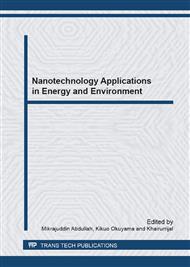p.54
p.60
p.67
p.74
p.80
p.85
p.93
p.98
p.105
Electrochemical Properties of P-Doped Silicon Thin Film Anodes of Lithium Ion Batteries
Abstract:
Silicon would seem to be a possible candidate to replace graphite or carbon as anode materials for lithium ion batteries based on its potential high capacity of 4200 mAhg-1. The main problem that must be solved for commercial application of silicon as anode material was the poor cyclic performance due to severe volume expansion during repeated charged-discharged cycles and its low electrical conductivity. In this work, we proposed Phosphorus doped (P-doped) Si films as anodes in lithium ion batteries. The electrochemical properties of the silicon based electrodes were examined by means of charge-discharge and impedance test. In comparison with the bare silicon electrode, the P type silicon electrode exhibited higher specific capacity of 2585 mAhg-1 until the 50th cycle. It was attributed to the improved electrical conductivity of Si film and reduced charge transfer resistance
Info:
Periodical:
Pages:
80-84
Citation:
Online since:
January 2013
Authors:
Keywords:
Price:
Сopyright:
© 2013 Trans Tech Publications Ltd. All Rights Reserved
Share:
Citation:


